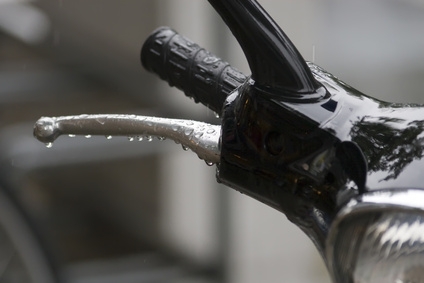
Three major categories of scooter painting exist: rattle-can, professional painting, and powder-coating. Each have benefits and drawbacks with the first being the lowest quality and lowest cost, and the last being the most permanent and hard to change after the fact.
Remove any parts from the scooter that can be detached. Unscrew mirrors with crescent wrenches, unbolt the seat with a socket wrench, and remove any accessories such as carrying racks. Pull out enough masking tape and tape off areas that you don't want painted, such as hand grips, floor rails, or plastic parts. Use a screwdriver to remove any screwed-in items that can be easily re-installed. Use sandpaper to smooth out blemishes or chips to a flat surface. Cover the wheels with tape and old newspaper.
Find an open-air location to perform the painting with a temperature above 70 degrees Fahrenheit. Using the primer spray-paint, steadily spray the scooter body in even patterns back and forth. Avoid painting one specific area for too long. Apply the primer in an even coat so that the result is a smooth surface of paint on every side. Perform the same task for any smaller body parts that were removable.
Take your choice of colored rattle-can paint and spray it over the dried primer paint. Use even patterns, avoiding any spot for too long. Spray at least three coats of the paint for a good layer to apply. Do not wait more than 20 minutes between coats. Allow the paint to dry for at least one full day, if not two. Carefully remove the masking tape when dry. Clean up any odd over-spray spots and re-install all the parts taken off the scooter.
Completely dismantle your scooter. Remove all cables, electrical, parts, and similar. Then remove the engine and suspension parts with crescent wrenches, screwdrivers and socket wrenches until the body parts are bare of any accessories or internals. Take the bare parts to a sandblaster to remove all old paint off metal body parts. Sand down plastic parts with smooth sandpaper to remove paint off plastic.
Take the bare, blasted/sanded parts to a professional automotive painter and select the paint color desired from options available at the service. Allow the paint service to perform their work. Pick up the parts and pay for the service upon satisfaction of the painting. Bring the parts back to a workspace and carefully lay them out so each part avoids banging or chipping the other.
Carefully reassemble the scooter part-by-part, avoiding any tools or metal parts from touching the newly painted body parts. Use blankets or shop clothes to protect areas that require manual work, and avoid dropping tools as much as possible. Wax the scooter body once all the parts are installed and buff the wax with a polishing towel.
Completely dismantle the scooter as described for the previous methods until all the scooter body parts are bare. Take all the metal parts to a sandblaster and pay for a complete cleaning of the parts down to the bare metal. Put plastic body parts aside for the meantime.
Retrieve the metal parts from the blaster and tape any threaded parts or areas not to be painted. Use a bright-colored tape so the painter knows where these spots are and avoids allowing powder-coat powder on them. Do not provide any plastic parts to the painter (they would melt in the baking oven).
Choose your paint color desired at the painter and allow the service to apply the paint powder and bake the paint onto the metal parts. Pay for the service upon satisfaction with the paint work. Pick up all painted parts and lay them out in your workspace. Primer and enamel paint the plastic parts to match your powder-coat color. Reassemble all the scooter parts carefully, making sure not to drop anything on the fresh dried paint. Wax the scooter body when completely constructed, and buff for a shiny look.